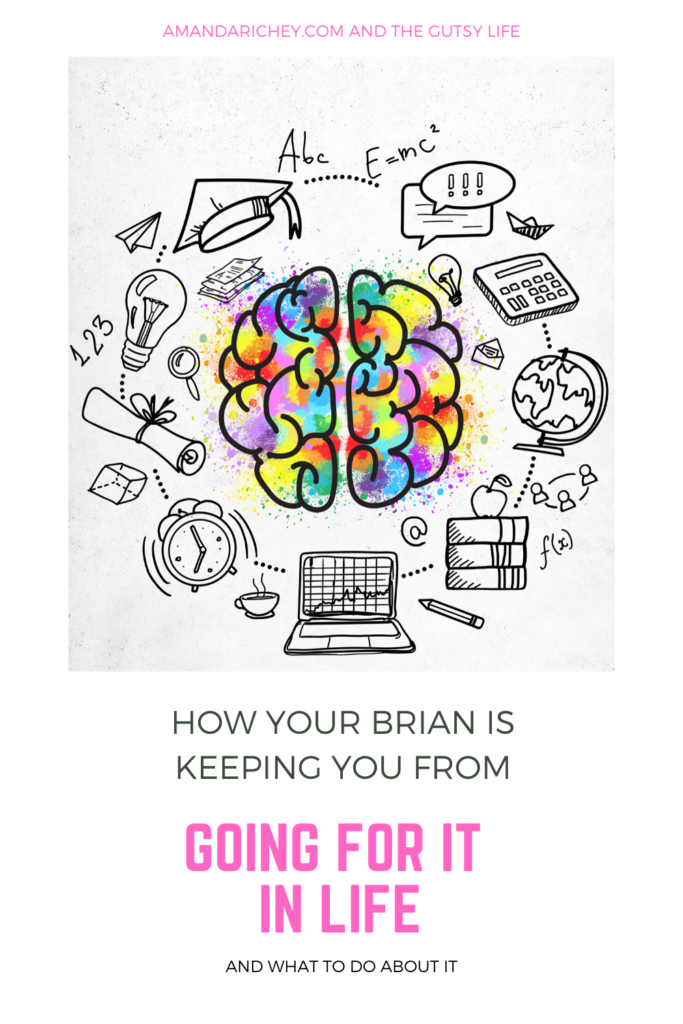How Your Brain is Keeping You From Going For It in Life

Understanding how your brain works is hugely important if you want to go for it in life, overcome your limiting beliefs, increase your willpower, and motivation, and step through fear to live the Gutsy Life. That is why I am diving into the science behind your brain and how to stop it from screwing your life!
As I delve deeper and deeper into thought work and cognitive psychology, I have come to realize one very important piece of information: Your brain is holding you back.
Now don’t get me wrong, the human brain is amazing. We would not have the incredible world we live in if not for the human brain, but the human brain’s primary goal is to keep you alive.
While this is a very noble goal, and one we all appreciate, your brain’s focus on survival keeps you from going for it in life.
Let me explain…
Your brain is hardwired for survival. (Blame it on 200,000 years plus of evolution!)
In survival mode, the brain focuses on conserving as much energy as possible and on scanning the world for any possible threat to that survival. Now, you might be thinking that threats are things like ax murderers, or lions on the savanna; obvious threats to your physical well-being.
But your brain perceives any potential for mental or physical harm as a threat, which means that your brain will respond to any new, different, or uncomfortable situation as a threat. When your brain perceives a threat, it moves into fear mode, setting off alarm bells that will prevent you from moving towards the threat.
Unfortunately, this means that when you want to try something new, different, or unknown (for your brain), your brain will start freaking out and try to stop you at all costs. This might sound extreme but hear me out…
The Science:
How Your brain creates Limiting Beliefs, Willpower and Motivation
We have a conscious mind and a subconscious mind. Our conscious mind is controlled by the prefrontal cortex, a section of your brain located right behind your forehead. This region is responsible for decision making, self-control, willpower, and regulating behavior, and does not fully develop until after puberty.
Our subconscious mind however, is fully developed at birth, and is controlled by the basal ganglia, which are responsible for emotions, habits, behavior, basic instincts, and ‘habit loops’, or ingrained behaviors you preform unconsciously.
This is great when it comes to breathing, or moving our limbs without thinking. But it is not great when we become stuck in the same old responses. Your brain, remember, is trying to conserve energy, so if it has found a path it has traveled before (a neural path) it will travel it again and again, because it knows it’s safe, creating a deeply entrenched habit loop.
This is a great way to conserve energy for survival, but not a great way to grow and develop new habits that serve you.
This is further complicated by the fact that our subconscious mind believes everything it takes in because it has no analytical filter. When we are young, this part of our brain is fully in charge (because the analytical part has not kicked in yet).
As a result, our subconscious mind takes in most of its information when we are children and don’t know how to filter. As children we take in all of the comments, facial cues, social norms of the people around us and internalize them as ‘truths’ or ‘beliefs’, even if they are not based on actual truth.
This means that the subconscious or habitual responses we have to the world around us today are based on ‘truths’ we internalized as children. Even if we know better now and could use our prefrontal cortex to analyze and rationalize these beliefs, our subconscious mind is still controlling and running the show; determining how and what we feel, think, and believe about ourselves and the world around us.

This is hugely important because, while you may have some awesome subconscious beliefs, chances are you have quite a few less awesome ‘beliefs’ that are not based in reality, and are thus limiting you and your potential (also known as limiting beliefs).
The other important part of your brain chemistry to understand is willpower. Willpower is not finite; it is controlled by the conscious mind and the prefrontal cortex. To aid your prefrontal cortex you must give it fuel: Sleep, good food, exercise, and a break from decision making, or you will risk decision fatigue.
Decision Fatigue is the idea that once you are mentally depleted, you are less likely to consider a trade-off or compromise. You might just pick the easiest, best, or cheapest option, for example. The more decisions you have to make in a day, specifically the ones that require self-control, the more decision fatigue you will experience, and by the end of the day your willpower will be next to gone! Understanding this and planning accordingly can alleviate decision fatigue and help you to stay the course and achieve your goals.
What to do about it
Identify Limiting Beliefs and Fear Responses
The first step is understanding how your brain works so you can recognize the limiting beliefs and fear responses before they take over. When you try to embark on a new, different, or uncertain path (even if your conscious mind wants to engage in the activity), your subconscious mind will either: Perceive a threat and initiate the ‘fear response’, or: Will bring up ‘beliefs’ you hold about yourself and the world that are antagonistic to what you are trying to accomplish.
To stop your brain from feeling threatened and responding in fear automatically (habit loops), you need to create new pathways. To do this you must change your thoughts.
Remember, your thoughts are what are telling your brain to be afraid, so if you can change your thoughts, you can change your response.
If your body goes into fear mode, tell your brain it is excitement! When your heart rate has increased and your body has become hyper alert, telling it that the feeling you are having is excitement instead of fear gives your brain something it can believe and focus on.
If your brain goes to the tried and true habits it knows and loves, count backwards from 5 and then act (the 5 Second Rule by Mel Robins). When you count backwards from five, the number one acts as a prompt to move (if you counted up you could just keep counting!) That prompt acts as a starting ritual which researchers have found to be a proven method of new habit formation.
This interrupts the old subconscious habits and engages your prefrontal cortex (conscious mind), helping you to push through fear, hesitation, and uncertainty and create new habits.
Remember, the key is understanding your brain so that you can begin to overcome your limiting beliefs, push through your fear, and increase your willpower and motivation! Good luck, I believe in you!



How long does it take to form new habits in such a way ? And does it actually work ? =)
It can take as little as 30 days, but you have to stick with the steps. Check out my post on Habits: https://www.amandarichey.com/how-to-form-good-habits/
Thank you very much for sharing, I learned a lot from your article. Very cool. Thanks. nimabi
I am glad you liked it!